
10 mistakes to avoid when buying pet insurance
Pets are beloved members of the family. They keep people company, play around the house, and help brighten up one’s mood. However, pet ownership also presents a significant amount of responsibility. Like humans, pets can fall sick and need expert care, which can be expensive. Pet insurance helps people save money on health and other costs linked to their furry friends. However, one must avoid making these ten mistakes when buying a policy.
Buying insurance too late
People often wait for their pets to get sick before buying insurance. This approach can be rather expensive for two reasons. First, insurance becomes expensive as a pet ages and/or develops health issues, likely leading to higher premiums and less coverage. Second, insurance providers may refuse to offer coverage for pre-existing conditions, leading to total disqualification or minimal coverage from the plan. To ensure their pet is covered under the best insurance plan, individuals must buy insurance while their furry companion is still young and free of severe health conditions.
Thinking of it as a savings plan
Pet insurance is neither an investment nor a savings plan. It is a risk management tool meant to protect against unexpected health conditions. The plan is similar to homeowner’s insurance, which helps people avoid financial stress during unexpected events, such as a fire or a flood. It is a good sign when one does not need to make a claim. If someone utilizes the available funds in their entirety, it indicates their pet is sick, which can be distressing.
Skipping a second opinion
Many people do not consult their veterinarian before getting pet insurance, which is a big mistake. Vets can help pet owners tailor the plan to their pet’s needs. Consulting a doctor before signing up for a pet insurance plan can also help people cut costs on add-ons they may not need. Although speaking to an expert may take time and effort, it is a beneficial step to consider.
Buying without researching
One must research well before buying any insurance plan, including pet insurance. Individuals must compare plans from different agencies to find the most suitable one. People can also consult other pet owners who have insurance and inquire about their experiences with filing claims, customer service, reimbursement, and other things. Further, checking customer reviews online can help make an informed decision.
Getting the wrong type
When buying insurance, one must consider the coverage they require and its associated costs. Not all policies are the same. For instance, accident-only policies offer a fixed sum per injury during accidents. They do not cover the cost of daily check-ups or appointments.
Generally, buyers must choose between comprehensive coverage, accident-only coverage, and pet wellness and health maintenance coverage. Some companies may offer add-ons or riders for conditions like cancer, diabetes, hip dysplasia, dental problems, behavioral disorders, and hereditary issues. Add-ons may also cover boarding and kenneling, prescription food, physical therapy, and end-of-life care.
Not reading the fine print
When getting any kind of insurance, one must read the fine print carefully. It can help people set realistic expectations regarding the support they will likely receive when their pet requires assistance. Many policies do not cover pre-existing conditions, routine care, flea or tick preventatives, spaying, neutering, breeding, or cosmetic procedures. Insurance providers may also place additional limits on chronic and congenital conditions. Reading the fine print before signing up for a pet insurance policy can help one find the best coverage for their pet’s needs.
Not asking questions
Generally, insurance companies publish a copy of their policy online. Pet owners can and must read this. In case of doubts or queries, one can talk to a customer service representative and develop a clearer understanding of the plan’s nitty-gritty. It is advisable to speak to both the insurer and vet to clarify any questions or concerns and make the best decision for the pet’s health.
Failing to understand how it works
Every insurance provider offers unique features and follows their own set of guidelines. They may follow unique protocols, right from policy purchase to claim reimbursement. Before signing up with a provider, one must carefully check what they are getting into. For example, does the policy have an annual deductible or per-incident? Are the reimbursements made on a benefit schedule or for a direct percentage of the bill? A better understanding of these caveats can help owners make the most of their insurance plans when the need arises.
Assuming everything is covered
People often assume pet insurance covers every accident or injury. Unfortunately, this is not the case. Insurance companies offer tiered plans for individuals to choose from. Additionally, they also review every case individually to determine the pet coverage. Further, some may have a waiting period, so insurance may not kick in right away.
Most comprehensive coverage plans have standard exclusions, such as pre-existing conditions, conditions occurring during the waiting period, breeding and pregnancy, deliberate injury caused by owners, cosmetic procedures, cloning, and grooming and boarding. One must verify this list with the insurance agent before signing up for a plan.
Not disclosing pre-existing conditions
When buying pet insurance, individuals must be honest and upfront about any pre-existing conditions their pet may have. Failing to do so may result in claim denials or policy cancellation, putting the pet’s health at risk.
On average, owners shelled out $53.34 and $32.25 monthly for comprehensive coverage for dogs and cats, respectively, last year. When buying pet insurance, one must remember that all plans are not created equal. Individuals should carefully read the documentation and grasp the fine print. To avoid disappointment later, one must also consider important factors, such as the required coverage, constraints, veterinarian choice, overall costs, and the provider’s reputation.


